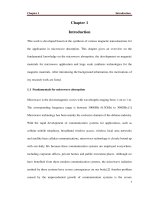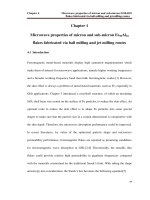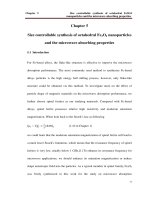Synthesis of various magnetic nanostructures and the microwave characterizations 3
Bạn đang xem bản rút gọn của tài liệu. Xem và tải ngay bản đầy đủ của tài liệu tại đây (1.03 MB, 10 trang )
Chapter 3 Synthesis and microwave absorbing properties
of Fe/SiO2 particles with core/shell structure
45
Chapter 3
Synthesis and microwave absorbing properties of Fe/SiO
2
particles with core/shell structure
3.1 Introduction
In recent years, the magnetic core-shell structure composites have attracted intense
attention for their novel performance in various applications, such as magnetic
resonance imaging,[1] optoelectronic devices[2] and microwave absorbing[3]. One
of the promising shell materials used in magnetic core-shell particles is silica (SiO
2
).
The use of silica shell provides several characteristics such as biocompatibility in
biological system, high suspension stability in various solvents, surface conductivity
modification and improved chemical stability of magnetic core materials.[4]
As is well known, iron particles are promising candidate for electromagnetic (EM)
wave absorption application. Iron as magnetic metal can maintain high
electromagnetic parameters at high frequency due to its large saturation magnetization
and higher Snoek’s limit.[5] However, serious energy loss caused by the eddy current
limits its application at higher frequency. To overcome this problem, it is necessary to
introduce an insulating shell to form a core/shell structure.[6,7] Besides the
advantages mentioned above, silica shell is chosen for another reason, i. e. the
synthesis methods. Among the various methods for core/shell composites fabrication,
Chapter 3 Synthesis and microwave absorbing properties
of Fe/SiO2 particles with core/shell structure
46
such as sol-gel,[8] heterogeneous precipitation,[9] arc discharge[10] and electroless
plating,[11] the Stöber process[12-14] is more popular and suitable for massive
product. The Stöber process is specially designed for the coating of silica on other
core materials.
The significance of an insulating shell layer to the microwave performance of Fe
particles was predicted by using the simulation models, which are given as
(3.1)
(3.2)
The calculation models were developed based on Landau-Lifshitz-Gilbert (LLG)
theory by our group members C. P. Neo et al.[15] It could be used to calculate the
effective electromagnetic parameters (
,
) of composite consisting of spherical
magnetic particles with core/shell structure dispersed in a medium. In this work, the
epoxy resin was used as the medium. Therefore,
and
. The schematic
illustration core/shell structure is shown in Fig. 3.1. As we can see,
and
are
the radius of the shell layer and the core particles, respectively. Similarly, the
parameters in Eq. (3.1) and Eq. (3.2) denoted as
and
are for the shell layer
materials, while those denoted as
and
are for the core materials. When SiO
2
is
used as the shell material, the parameters are known to be
and
= 1.0.
Chapter 3 Synthesis and microwave absorbing properties
of Fe/SiO2 particles with core/shell structure
47
refers to the volume concentration of magnetic materials in the composite.
In this chapter, Fe/SiO
2
core/shell structure was prepared through the Stöber process.
The electromagnetic performance was performed on Fe/SiO
2
/Epoxy composite with
three different volume concentrations. The experimental results were used to compare
with the calculated results to verify the effectiveness of the calculation models.
Furthermore, the microwave absorbing performance of as-synthesized core/shell
structure was investigated.
3.2 Experimental results
3.2.1 Characterizations on the Fe/SiO
2
core/shell structure
The particle sizes of commercial carbonyl iron particles are in the range of 1.29±0.58
μm, as evaluated from electron micrographs by counting over two hundred particles.
The SEM images of Fe and Fe/SiO
2
particles are shown in Fig. 3.1a&b. As seen from
the images, the surface morphology changed obviously due to the silica coating. The
presence of Si on the surface of Fe particles is also evidenced by the EDS spectrum
and elemental mapping. The chemical analysis from the EDS spectrum in Fig. 3.2d
Fig. 3.1
An inhomogeneous sphere with a spherical
core and a spherical layer.
Chapter 3 Synthesis and microwave absorbing properties
of Fe/SiO2 particles with core/shell structure
48
provides an atomic ratio of Fe to Si about 5.4. Fig. 3.2(e1, e2, e3 and e4) are
elemental mappings of C, O, Fe and Si, respectively, as labeled in the images. The
carbon shown in both of the EDS spectrum and the mapping images is mainly from
the conductive carbon paste. Fig. 3.2c shows the TEM image of Fe/SiO
2
particles
which clearly reveals the core/shell structure. The thickness of the shell layer is
uniform and measured to be around 140±12 nm. Compared with the uncoated Fe
particles, the saturation magnetization of silica coated Fe decreases by 12.8%, as
indicated by the magnetic hysteresis loops in Fig. 3.2f.
3.2.2 Investigations on the electromagnetic parameters
The filler volume concentrations of as prepared composites (Fe/Epoxy,
Fe/SiO
2
/Epoxy) are 8.6%, 15.5% and 26.3%. Similar trend is observed in the
Fig. 3.2 SEM images of (a) Fe particles and (b) Fe/SiO
2
particles; (c) TEM images of
Fe/SiO
2
particles; (d) EDS spectrum of Fe/SiO
2
particles; (e1) ~ (e4) are elemental
mapping corresponding to C, O, Fe and Si, respectively; (f) Magnetic hysteresis
loops of Fe Fe/SiO
2
particles. The scale bars in (a), (b) and (c) stand for 1μm.
Chapter 3 Synthesis and microwave absorbing properties
of Fe/SiO2 particles with core/shell structure
49
Fig. 3.3 Comparison of experimental results: (a) the complex permittivity and (b)
complex permeability of Fe/Epoxy and Fe/SiO
2
/Epoxy composites. The volume
concentration of magnetic filler is 8.6%.
Fig. 3.4 Comparison of experimental results: (a) the complex permittivity and (b)
complex permeability of Fe/Epoxy and Fe/SiO
2
/Epoxy composites. The volume
concentration of magnetic filler is 15.5%.
Fig. 3.5 Comparison of experimental results: (a) the complex permittivity and (b)
complex permeability of Fe/Epoxy and Fe/SiO
2
/Epoxy composites. The volume
concentration of magnetic filler is 26.3%.
Chapter 3 Synthesis and microwave absorbing properties
of Fe/SiO2 particles with core/shell structure
50
experimental results, as shown in Fig. 3.3, Fig 3.4 and Fig.3.5. The effective
permeability of Fe/SiO
2
/Epoxy composite change little compared with that of
Fe/Epoxy composite, however, an obvious decrease of the real part of permittivity
due to the silica coating layer could be found. This phenomenon exists for all the
samples with different filler concentrations. The results might suggest two advantages
of Fe/SiO
2
core/shell particles to be used as microwave absorbing materials. The one
is that the skin effect is reduced by the insulating coating layer. To the best of my
knowledge, the skin effect usually limits the application of iron particles, especially at
relative GHz frequency range. Hence the suppression of the skin effect may increase
the resonance frequency. The other is that the lower permittivity value of
Fe/SiO
2
/Epoxy composite makes its impedance closer to that of the free space, so the
microwave can permeate into the composite more easily, resulting in a more effective
attenuation of incident microwaves.
3.2.3 The comparison between the measured electromagnetic performance
and the calculated results
The effective permeability (
) and effective permittivity (
) were measured
and calculated based on Eq. (3.1) and Eq. (3.2). The figures in Fig. 3.6 are shown to
present the comparison of computed effective permeability and permittivity of three
volume concentrations of Fe/SiO
2
particle composites with the measurement results.
As expected, the permittivity and permeability increase with increasing volume
Chapter 3 Synthesis and microwave absorbing properties
of Fe/SiO2 particles with core/shell structure
51
fraction. The computed results agree quite well with the measurement results. The
agreement is better for smaller volume concentration, which may be explained by the
better dispersion of Fe/SiO
2
particles in the medium at a smaller volume concentration.
The effective permeability and the effective permittivity are important parameters to
obtain the reflection loss, therefore the prediction on these parameters is important to
study the microwave absorption performance.
3.2.4 Evaluation on the microwave absorbing performance
To find out the effect of the silica coating layer on the microwave absorbing
performance, the reflection loss (RL) curves of Fe/Epoxy and Fe/SiO
2
/Epoxy
composites are calculated from the measured complex permeability (
)
and permittivity (
) of the composites. The reflection loss (RL) was
Fig. 3.6 Comparisons between calculated and experimental results of the effective
electromagnetic parameters for Fe/SiO
2
composites. The filler concentration is
labeled on top of figures.
Chapter 3 Synthesis and microwave absorbing properties
of Fe/SiO2 particles with core/shell structure
52
calculated from the measured
and
at given frequency and absorber thickness
according to Eq. (2.5) and Eq. (2.6).
The measured complex permeability and permeability shown in Fig. 3.4a&b are used
to obtain the RL curves of Fe/Epoxy and Fe/SiO
2
/Epoxy composites with volume
concentration of 15.5%, and the resultant RL curves are shown in Fig. 3.7. As seen
from the results, the optimal thickness of Fe/Epoxy composite is 3 mm, corresponding
to a lowest RL value of -20.5 dB at the frequency of 8.5 GHz, and the frequency band
with RL lower -10 dB is around 4 GHz. The RL value of -10 dB means that 90% of
incident microwave is absorbed by the absorbing materials, and the frequency band
with RL lower than -10 dB is an important criterion to evaluate the microwave
performance. The broader the frequency band, the better the microwave performance.
For the Fe/SiO
2
/Epoxy composite, the optimal thickness does not show up in the
calculated thickness range of 2.2 mm to 3.4 mm. When the thickness of the
Fig. 3.7 The calculated reflection loss curves for (a) Fe/Epoxy composite and (b)
Fe/SiO
2
/Epoxy composite. The thicknesses of the microwave absorbers are
assumed to be 2.2 mm, 2.6 mm, 3 mm and 3.4 mm for calculation.
Chapter 3 Synthesis and microwave absorbing properties
of Fe/SiO2 particles with core/shell structure
53
absorber gets smaller, the lowest RL value keeps decreasing towards to higher
frequency range. With , the lowest RL value of Fe/SiO
2
/Epoxy composite
is -17 dB at 13.6 GHz, and the frequency band with RL lower than -10 dB is around
5.12 GHz. These results can illustrate the improvement of the insulating SiO
2
shell
layer on the microwave absorption performance of Fe particles.
3.3 Summary
In this chapter, the commercial carbonyl iron particles were coated by 140nm-silica
shell layer through Stöber method. Compared with Fe composite, the effective
permittivity of Fe/SiO
2
composite decreases dramatically, while the effective
permeability changes little. The results indicate that the insulating coating layer of
SiO
2
on the Fe particles is effective to reduce the skin effect. The improvement is also
shown by the reflection loss curves at relative high frequency (above 12 GHz). The
absorption peak of Fe/SiO
2
/Epoxy composite corresponding to the lowest reflection
loss shifts to higher frequency comparing with Fe/Epoxy composite. Furthermore, the
optimal thickness of Fe/SiO
2
/Epoxy composite is smaller than that of Fe/Epoxy
composite, which renders it suitable for thinner and lighter microwave absorber.
Furthermore, the calculation models on the effective permeability and the effective
permittivity are significant to the microwave absorption performance estimation.
Chapter 3 Synthesis and microwave absorbing properties
of Fe/SiO2 particles with core/shell structure
54
3.4 References
[1] S. Cheong, P. Ferguson, K. W. Feindel, I. F. Hermans, P. T. Callaghan, C. Meyer, A.
Slocome, C. H. Su, F. Y. Cheng, C. S. Yeh, B. Ingham, M. F. Toney, R. D. Tilley, Angew
Chem. Int. Ed., 50, 4206-4209 (2011).
[2] Y. L. Chueh, C. H. Hsieh, M. T. Chang, L. J. Chou, C. S. Lao, J. H. Song, J. Y. Gan, Z. L.
Wang, Adv. Mater., 19, 143-149 (2007).
[3] C. Wang, R. T. Lv, Z. H. Huang, F. Y. Kang, J. L. Gu, J. Alloys Compd., 509, 494- 498
(2011).
[4] V. K. Varadan, L. Chen, J. Xie, Magnetic Nanoparticles, in Nanomedicine: Design and
Applications of Magnetic Nanomaterials, Nanosensors and Nanosystems. John Wiley & Sons,
Ltd, p108 (2008).
[5] X. M. Ni, Z. Zheng, X. Hu, X. L. Xiao. J. Colloid. Interface Sci., 341, 18-22 (2010).
[6] X. Yan, G. Z. Chai, D. S. Xue, J. Alloys Compd., 509, 1310-1313 (2011).
[7] V. Sunny, D. S. Kumar, P. Mohanan, M. R. Anantharaman, Mater. Lett., 64, 1130-1132
(2010).
[8] X. J. Wei, J. T. Liang, L. Zhen, Y. X. Gong, W. Z. Shao, C. Y. Xu, Mater. Lett., 64, 57-60
(2010).
[9] X. F. Meng, X. Q. Shen, W. Liu, Appl. Surf. Sci., 258, 2627-2631(2012).
[10] X. F. Zhang F, X. L. Dong, H. Huang, Y. Y. Liu, W. N. Wang, Appl. Phys. Lett., 89,
053115 (2006).
[11] H. J. Zhang, X. W. Wu, Q. L. Jia, X. L. Jia, Mater. Des., 28,1369-1373 (2007).
[12] X. G. Lu, G. Y. Liang, Y. M. Zhang, Mater. Lett., 61,4928-4931(2007).
[13] X. M. Ni, Z. Zhong, X. K. Xiao, L. Huang, L. He, Mater. Chem. Phys., 120, 206- 212
(2010).
[14] Y. C. Qing, W. C. Zhou, S. Jia, F. Luo, D. M. Zhu, Physica B, 406, 777-780 (2011).
[15] C. P. Neo, Calculations of Microwave Permeability, Permittivity and Absorption
Properties of Magnetic Particle Composites, PhD Thesis, National University of Singapore,
2010.









